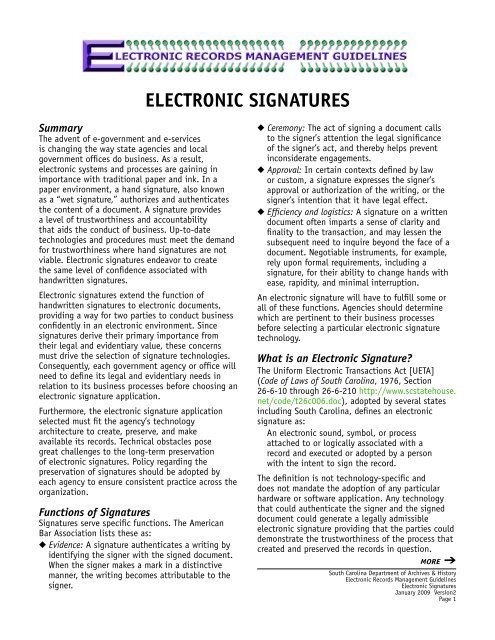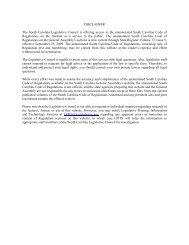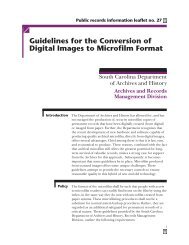ELECTRONIC SIGNATURES - Records Management
ELECTRONIC SIGNATURES - Records Management
ELECTRONIC SIGNATURES - Records Management
Create successful ePaper yourself
Turn your PDF publications into a flip-book with our unique Google optimized e-Paper software.
<strong>ELECTRONIC</strong> <strong>SIGNATURES</strong><br />
Summary<br />
The advent of e-government and e-services<br />
is changing the way state agencies and local<br />
government offices do business. As a result,<br />
electronic systems and processes are gaining in<br />
importance with traditional paper and ink. In a<br />
paper environment, a hand signature, also known<br />
as a “wet signature,” authorizes and authenticates<br />
the content of a document. A signature provides<br />
a level of trustworthiness and accountability<br />
that aids the conduct of business. Up-to-date<br />
technologies and procedures must meet the demand<br />
for trustworthiness where hand signatures are not<br />
viable. Electronic signatures endeavor to create<br />
the same level of confidence associated with<br />
handwritten signatures.<br />
Electronic signatures extend the function of<br />
handwritten signatures to electronic documents,<br />
providing a way for two parties to conduct business<br />
confidently in an electronic environment. Since<br />
signatures derive their primary importance from<br />
their legal and evidentiary value, these concerns<br />
must drive the selection of signature technologies.<br />
Consequently, each government agency or office will<br />
need to define its legal and evidentiary needs in<br />
relation to its business processes before choosing an<br />
electronic signature application.<br />
Furthermore, the electronic signature application<br />
selected must fit the agency’s technology<br />
architecture to create, preserve, and make<br />
available its records. Technical obstacles pose<br />
great challenges to the long-term preservation<br />
of electronic signatures. Policy regarding the<br />
preservation of signatures should be adopted by<br />
each agency to ensure consistent practice across the<br />
organization.<br />
Functions of Signatures<br />
Signatures serve specific functions. The American<br />
Bar Association lists these as:<br />
◆ Evidence: A signature authenticates a writing by<br />
identifying the signer with the signed document.<br />
When the signer makes a mark in a distinctive<br />
manner, the writing becomes attributable to the<br />
signer.<br />
◆ Ceremony: The act of signing a document calls<br />
to the signer’s attention the legal significance<br />
of the signer’s act, and thereby helps prevent<br />
inconsiderate engagements.<br />
◆ Approval: In certain contexts defined by law<br />
or custom, a signature expresses the signer’s<br />
approval or authorization of the writing, or the<br />
signer’s intention that it have legal effect.<br />
◆ Efficiency and logistics: A signature on a written<br />
document often imparts a sense of clarity and<br />
finality to the transaction, and may lessen the<br />
subsequent need to inquire beyond the face of a<br />
document. Negotiable instruments, for example,<br />
rely upon formal requirements, including a<br />
signature, for their ability to change hands with<br />
ease, rapidity, and minimal interruption.<br />
An electronic signature will have to fulfill some or<br />
all of these functions. Agencies should determine<br />
which are pertinent to their business processes<br />
before selecting a particular electronic signature<br />
technology.<br />
What is an Electronic Signature?<br />
The Uniform Electronic Transactions Act [UETA]<br />
(Code of Laws of South Carolina, 1976, Section<br />
26-6-10 through 26-6-210 http://www.scstatehouse.<br />
net/code/t26c006.doc), adopted by several states<br />
including South Carolina, defines an electronic<br />
signature as:<br />
An electronic sound, symbol, or process<br />
attached to or logically associated with a<br />
record and executed or adopted by a person<br />
with the intent to sign the record.<br />
The definition is not technology-specific and<br />
does not mandate the adoption of any particular<br />
hardware or software application. Any technology<br />
that could authenticate the signer and the signed<br />
document could generate a legally admissible<br />
electronic signature providing that the parties could<br />
demonstrate the trustworthiness of the process that<br />
created and preserved the records in question.<br />
MORE ➔<br />
South Carolina Department of Archives & History<br />
Electronic <strong>Records</strong> <strong>Management</strong> Guidelines<br />
Electronic Signatures<br />
January 2009 Version2<br />
Page 1
South Carolina Standards for<br />
Electronic Signatures<br />
In February 2007, the South Carolina State Budget<br />
and Control Board through its Architecture Oversight<br />
Committee (AOC) approved the SC Standards for<br />
Electronic Signatures.<br />
http://cio.sc.gov/NR/rdonlyres/A825AF86-8FDA-<br />
4A63-8A02-8907639020EC/0/scrUETASCStandardsfor<br />
ElectronicSignatures.pdf<br />
These standards, promulgated to comply with<br />
the UETA, are applicable to all state government<br />
entities including agencies, boards, commissions,<br />
colleges and universities. Local governments may,<br />
at their discretion, consent to be governed by these<br />
standards.<br />
All programs implemented by state government<br />
entities which utilize electronic signatures shall<br />
meet the following conditions:<br />
◆ Use of signature unique to the signer: The<br />
electronic signature must uniquely identify the<br />
signer, and must be under reasonable control of<br />
the signer. That is, it must be unlikely that any<br />
other unauthorized entity provided the signature.<br />
◆ Agreement by the parties: A party signs<br />
a document in order to convey a mutually<br />
understood message to another party, such as<br />
authorship, receipt, or approval of the document.<br />
In the case of an electronic signature, both the<br />
signer and the intended recipient of the signed<br />
document must agree that the electronic sound,<br />
symbol, or action will be accepted as serving as a<br />
signature for the electronic document or record.<br />
◆ Intent to sign: The application of the electronic<br />
signature to the electronic record must be a<br />
deliberate act. It cannot be implied or inferred.<br />
◆ Association of the signature with the<br />
signed record: The electronic signature must<br />
be physically or logically associated with the<br />
electronic record that is signed, and that<br />
association must persist for as long as the<br />
signature is in effect, which may be the life of<br />
the record.<br />
The degree to which each of the above conditions<br />
is met is dependent on several factors normally<br />
associated with security concerns:<br />
◆ Authentication: the ability to prove that the<br />
actual signer is the intended signer<br />
◆ Non-Repudiation: the inability of the signer to<br />
deny the signature<br />
◆ Integrity: the assurance that neither the record<br />
nor the signature has been altered since the<br />
moment of signing.<br />
For additional detail on the standards and assistance<br />
with implementation, refer to the South Carolina<br />
Electronic Signatures Analysis and Implementation<br />
Guide.<br />
http://cio.sc.gov/NR/rdonlyres/9F3BA2ED-7A88-<br />
4EE4-A090-93BB482B1502/0/scrUETASCAnalysisandI<br />
mplementationGuideforElecSignatures.pdf<br />
Types of Electronic Signature Technologies<br />
There are a number of currently available electronic<br />
signature technologies that are capable of meeting<br />
state standards. Examples include PIN/password,<br />
physical token, digitized signature, biometric<br />
signature, and digital signature. For complete<br />
descriptions and specific examples of state<br />
government applications using these technologies,<br />
refer to Sections 10 and 11 of the South Carolina<br />
Electronic Signatures Analysis and Implementation<br />
Guide.<br />
http://cio.sc.gov/NR/rdonlyres/9F3BA2ED-7A88-<br />
4EE4-A090-93BB482B1502/0/scrUETASCAnalysisandI<br />
mplementationGuideforElecSignatures.pdf<br />
Regardless of the technology chosen, the key to<br />
demonstrating the trustworthiness of a record and<br />
its signature is by demonstrating and documenting<br />
the trustworthiness of the system that creates<br />
and manages the record and signature. Therefore,<br />
sufficient and appropriate systems documentation<br />
is the only way to establish that the signature is<br />
authentic and reliable. For more information on<br />
building and managing system trustworthiness,<br />
see the Trustworthy Information Systems Handbook.<br />
http://arm.scdah.sc.gov/erp/tishandbook.htm<br />
Issues to Consider<br />
No electronic signature technology by itself is<br />
sufficient to meet all legal needs. The evidentiary<br />
value of signed records will ultimately rely on<br />
an agency’s ability to produce legally admissible<br />
documentation of its recordkeeping system. In<br />
addition, the agency will, of course, have to produce<br />
the electronic records themselves. Merely preserving<br />
and providing access to electronic records present<br />
daunting challenges. Adding electronic signatures<br />
to the equation can complicate the situation even<br />
further.<br />
While every technology option has its own<br />
advantages and disadvantages, some issues remain<br />
constant:<br />
MORE ➔<br />
South Carolina Department of Archives & History<br />
Electronic <strong>Records</strong> <strong>Management</strong> Guidelines<br />
Electronic Signatures<br />
January 2009 Version2<br />
Page 2
◆ Hardware and software obsolescence make it<br />
difficult, if not impossible, to preserve and<br />
provide long-term or permanent access to both<br />
the electronic signature and the associated<br />
electronic record. For example, if an agency is<br />
using different technologies to create and to<br />
sign a record, those technologies might “age”<br />
at different rates. In a digital signature (PKI)<br />
system, the signature is a function of the content<br />
of the document. Due to this relationship, any<br />
migration or conversion of the document’s<br />
content for preservation will nullify the original<br />
digital signature and prevent its use as a means<br />
to ensure the authenticity and reliability of that<br />
document. Therefore, agencies will need to plan<br />
for technology obsolescence of both the record<br />
and the signature if long-term preservation of<br />
electronic signatures is desirable.<br />
◆ Agencies should plan to document their decisions<br />
and transactions. Understanding legal needs<br />
and addressing them at the design phase of<br />
an application are important factors to making<br />
this work. Keeping documentation up-to-date<br />
is an on-going responsibility, which could be<br />
complicated if relying on a third party. For<br />
example, when using digital signatures agencies<br />
should make sure that the certificate authority<br />
is managing its records and documentation<br />
adequately.<br />
◆ Agencies should make sure that the electronic<br />
signature technology is interoperable with<br />
their and their constituencies’ other software<br />
applications. Requiring complex or expensive<br />
solutions is probably not practical. It would be<br />
especially difficult to ask citizens to buy and<br />
maintain multiple signature technologies.<br />
◆ Agencies should assess risks associated with<br />
the use of electronic signature technology and<br />
develop a well-documented risk management<br />
plan based upon the risks identified. Information<br />
on the issues to be considered in assessing and<br />
managing risks can be found in Section 4 of the<br />
South Carolina Electronic Signatures Analysis and<br />
Implementation Guide.<br />
http://cio.sc.gov/NR/rdonlyres/9F3BA2ED-7A88-<br />
4EE4-A090-93BB482B1502/0/scrUETASCAnalysisa<br />
ndImplementationGuideforElecSignatures.pdf<br />
◆ The human side of the equation is critical: no<br />
technology will completely address your legal<br />
requirements. For example, a digital signature<br />
is only as reliable as the certificate authority<br />
standing behind it as well as the ability of the<br />
users to protect personal certificate information<br />
from loss or inappropriate use.<br />
Selecting the appropriate electronic signature<br />
technology means defining the most important<br />
criteria and then determining if the system and<br />
proposed application meet those criteria. The<br />
criteria should give priority to legal concerns, since<br />
signatures are primarily valuable for evidentiary<br />
purposes. A selection decision should also reflect<br />
consideration of other factors, such as technology<br />
architectures, costs/benefits, agency business<br />
practices, and all pertinent policies, hardware,<br />
software, controls, and audit procedures.<br />
Guidance with selecting and implementing the<br />
appropriate electronic signature technology can be<br />
found in the South Carolina Electronic Signatures<br />
Analysis and Implementation Guide.<br />
http://cio.sc.gov/NR/rdonlyres/9F3BA2ED-7A88-<br />
4EE4-A090-93BB482B1502/0/scrUETASCAnalysisandI<br />
mplementationGuideforElecSignatures.pdf<br />
A model of and methodology for information system<br />
development and assessment can be found in the<br />
Trustworthy Information Systems Handbook.<br />
http://arm.scdah.sc.gov/erp/tishandbook.htm<br />
A specific example of the criteria pertinent to<br />
a digital signature application can be found in<br />
the American Bar Association’s PKI Assessment<br />
Guidelines.<br />
www.abanet.org/scitech/ec/isc/pag/pag.html)<br />
Suggestions for the use of electronic<br />
signature technology<br />
All agencies should:<br />
◆ Clarify the reasons for using electronic signatures<br />
and determine what business functions the<br />
technology will support.<br />
◆ Determine who will use and rely on the electronic<br />
signature.<br />
◆ Consider how long the signatures and the records<br />
to which the electronic signatures are affixed<br />
need to be preserved and how the signatures and<br />
records will be preserved in a way that balances<br />
the ability to retrieve and read a record with the<br />
ability to verify its signature.<br />
◆ Verify which state and federal statutes pertain to<br />
the functions and transactions that generate the<br />
signed records and determine what case law is<br />
available.<br />
◆ Determine how the electronic signature<br />
technology fits into the overall technology<br />
architecture, what is the cost per transaction, and<br />
what is the total cost of the technology.<br />
MORE ➔<br />
South Carolina Department of Archives & History<br />
Electronic <strong>Records</strong> <strong>Management</strong> Guidelines<br />
Electronic Signatures<br />
January 2009 Version2<br />
Page 3
◆ Consider what sort of electronic signature<br />
technologies customers use and if records will<br />
have to be shared with any other organizations or<br />
agencies.<br />
◆ Establish a methodology for documenting<br />
information systems, policies, and practices.<br />
Legal Framework<br />
There are a number of statutes pertaining to<br />
government records which agencies need to<br />
understand because any document signed in<br />
the course of an official transaction becomes a<br />
government record. Among the most important are:<br />
◆ South Carolina Public <strong>Records</strong> Act [PRA] (Code<br />
of Laws of South Carolina, 1976, Section 30-1-10<br />
through 30-1-140, as amended) available at www.<br />
scstatehouse.net/code/t30c001.doc. The PRA<br />
supports government accountability by mandating<br />
the use of retention schedules to manage records<br />
of South Carolina public entities. This law<br />
governs the management of all records created by<br />
agencies or entities supported in whole or in part<br />
by public funds in South Carolina. Section 30-1-<br />
70 establishes agency responsibility to protect<br />
records and to make them available for easy use.<br />
The act does not discriminate between media<br />
types. Therefore, records created or formatted<br />
electronically are covered under the act.<br />
◆ South Carolina Uniform Electronic Transactions<br />
Act [UETA] (Code of Laws of South Carolina, 1976,<br />
Section 26-6-10 through 26-6-210) available<br />
at http://www.scstatehouse.net/code/t26c006.<br />
doc. The UETA facilitates electronic commerce<br />
and electronic government services by legally<br />
placing electronic records and signatures on<br />
equal footing with their paper counterparts. The<br />
purpose of UETA is to establish policy relating<br />
to the use of electronic communications and<br />
records in contractual transactions. This law<br />
does not require the use of electronic records<br />
and signatures but allows for them where agreed<br />
upon by all involved parties. While technologyneutral,<br />
the law stipulates that all such records<br />
and signatures must remain trustworthy and<br />
accessible for later reference as required by<br />
law. Similarly, the federal Electronic Signatures<br />
in Global and National Commerce (E-Sign) Act<br />
[U.S. Public Law 106-229] encourages the use of<br />
electronic documents and signatures, although it<br />
goes further to provide some guidelines regarding<br />
standards and formats. More information on<br />
UETA can be found in Appendices A6 and A7 of<br />
the Trustworthy Information Systems Handbook.<br />
http://arm.scdah.sc.gov/erp/tishandbook.htm<br />
◆ The Health Insurance Portability & Accountability<br />
Act of 1996 [HIPAA] (Public Law 104-191)<br />
establishes security and privacy standards<br />
for health information. The Act protects the<br />
confidentiality and integrity of “individually<br />
identifiable health information,” past, present<br />
or future. HIPAA is also concerned with nonrepudiation.<br />
Non-repudiation “provides assurance<br />
of the origin or delivery of data,” so that the<br />
sender cannot deny sending a message and the<br />
receiver cannot deny receiving it. This prevents<br />
either party from modifying or breaking a legal<br />
relationship unilaterally. HIPAA holds that only a<br />
digital signature technology can currently provide<br />
that assurance.<br />
Annotated List of Resources<br />
Primary Resources<br />
American Bar Association. Digital Signature<br />
Guidelines Tutorial. Washington, D.C.: American Bar<br />
Association, 1996.<br />
www.abanet.org/scitech/ec/isc/dsg-tutorial.html<br />
In 1996, the ABA’s Section on Science and<br />
Technology produced the first legal overview of<br />
electronic and digital signatures, as well as related<br />
concerns. Although there have been many legal<br />
and technological developments in the years since,<br />
the site still contains fundamental information<br />
on signatures that is of value. The term “tutorial”<br />
is slightly misleading; this is basically a short<br />
essay, but it is the best introduction to signatures<br />
available. It has recently been complemented by<br />
the ABA’s PKI Assessment Guideline.<br />
American Bar Association. PKI Assessment<br />
Guidelines. Washington, D.C.: American Bar<br />
Association, 2001.<br />
www.abanet.org/scitech/ec/isc/pag/pag.html<br />
The Information Security Committee of the<br />
Electronic Commerce Division of the ABA issued<br />
a draft version of its PKI Assessment Guidelines<br />
(PAG) in 2001. The PAG offers a practical guide for<br />
the evaluation and assessment of PKI systems and<br />
vendors. This is a very detailed document, almost<br />
four hundred pages long. It is available as a PDF<br />
file. As noted, it is currently a draft and will be<br />
updated in the future.<br />
MORE ➔<br />
South Carolina Department of Archives & History<br />
Electronic <strong>Records</strong> <strong>Management</strong> Guidelines<br />
Electronic Signatures<br />
January 2009 Version2<br />
Page 4
South Carolina Enterprise Architecture. Uniform<br />
Electronic Transactions Act, SC Standards for<br />
Electronic <strong>Records</strong>, February 28, 2007.<br />
http://cio.sc.gov/NR/rdonlyres/A825AF86-8FDA-<br />
4A63-8A02-8907639020EC/0/scrUETASCStandardsfor<br />
ElectronicSignatures.pdf<br />
The standards promulgated in this document<br />
were created in an effort to comply with the<br />
purpose and intent of the Uniform Electronic<br />
Transactions Act (UETA — S.C. Code Ann. 26-6-10<br />
et seq.). South Carolina Code Section 26-6-190<br />
of UETA, entitled Development of standards and<br />
procedures; service of process.<br />
South Carolina Architecture Oversight Committee<br />
UETA Task Force. South Carolina Electronic Signatures<br />
Analysis and Implementation Guide, March 28,2007.<br />
http://cio.sc.gov/NR/rdonlyres/9F3BA2ED-7A88-<br />
4EE4-A090-93BB482B1502/0/scrUETASCAnalysisandI<br />
mplementationGuideforElecSignatures.pdf<br />
Proposed by the UETA Task Force to the South<br />
Carolina Architecture Oversight Committee,<br />
this document expands upon the four factors<br />
comprising the SC Standards for Electronic<br />
Signatures and explores some of the<br />
implementation considerations in each of the four<br />
areas. The document also provides descriptions<br />
of various electronic signature technologies and<br />
examples of state agency applications using those<br />
technologies.<br />
Electronic and Digital Signature Resources<br />
McBride Baker & Coles. Legislative Analysis Database<br />
for E-Commerce and Digital Signatures. Chicago, IL:<br />
McBride Baker & Coles, 2001.<br />
McBride Baker & Coles is a Chicago law firm with<br />
an interest in information technology and the law.<br />
The Legislative Analysis Database for E-Commerce<br />
and Digital Signatures is a set of tables that<br />
allow for the comparative analysis of practices<br />
in different states. These tables systematically<br />
list and distinguish enacted digital signature<br />
legislation and uniform laws. The firm’s<br />
e-commerce site provides a variety of other tables<br />
for study of pertinent issues around the world.<br />
National Institute of Standards and Technology<br />
(NIST), U.S. Department of Commerce. Cryptographic<br />
Toolkit: Digital Signatures. Washington, D.C.: NIST,<br />
2001.<br />
http://csrc.nist.gov/encryption/tkdigsigs.html<br />
NIST’s web site provides access to three Federal<br />
Information Processing Standards (FIPS) for digital<br />
signature algorithms, along with a variety of other<br />
resources on cryptography.<br />
<strong>Records</strong> <strong>Management</strong> Guidance for PKI-Unique<br />
Administrative <strong>Records</strong>. Washington DC: National<br />
Archives and <strong>Records</strong> Administration, 2005.<br />
www.archives.gov/records-mgmt/policy/pki.html<br />
This document contains NARA’s records<br />
management guidance for PKI-unique records<br />
created by federal agencies. It identifies records<br />
produced and managed by PKI operational systems<br />
and advises agencies on records management<br />
best practices. The guidance relies on agencies to<br />
determine specific retention periods for PKI-unique<br />
records. Non-unique PKI supporting records and<br />
non-administrative PKI transactional records are<br />
not covered. The guidance does not recommend or<br />
identify specific technology or products.<br />
PKI Resources<br />
www.pkiforum.org/<br />
The PKI Forum is an international, non-profit<br />
alliance of vendors and users interested in PKI<br />
products and services. It maintains online an<br />
extensive list of resources, arranged by topic<br />
and country. There is information on certificate<br />
authorities, digital signature laws, security,<br />
policies, and vendors. Also available are a<br />
number of white papers on topics including<br />
interoperability. PKI Forum sponsors quarterly<br />
meetings. Memberships are required to gain all the<br />
advantages of the organization.<br />
South Carolina Department of Archives and History.<br />
Trustworthy Information Systems Handbook.<br />
Version 2, March 2007.<br />
http://arm.scdah.sc.gov/erp/tishandbook.htm<br />
This handbook provides an overview for all<br />
stakeholders involved in government electronic<br />
records management. Topics focus on<br />
accountability by developing systems that create<br />
reliable and authentic information and records. The<br />
handbook outlines the characteristics that define<br />
trustworthy information, offers a methodology for<br />
ensuring trustworthiness, and provides a series of<br />
worksheets and tools for evaluating and refining<br />
system design and documentation.<br />
MORE ➔<br />
South Carolina Department of Archives & History<br />
Electronic <strong>Records</strong> <strong>Management</strong> Guidelines<br />
Electronic Signatures<br />
January 2009 Version2<br />
Page 5
Additional Resources<br />
Commonwealth of Australia. Gatekeeper. Canberra,<br />
Australia: National Office for the Information<br />
Economy, 2000.<br />
www.agimo.gov.au/infrastructure/gatekeeper<br />
Gatekeeper is the strategy Australia is using for<br />
the development of PKI in e-government. The site<br />
includes basic information on the use of PKI, FAQs,<br />
and criteria for accrediting certificate authorities.<br />
Since Australia has been an innovative force in<br />
the development of electronic records standards<br />
and e-government services, its electronic signature<br />
projects are generally worth analyzing. One<br />
aspect that is of special interest is the concern for<br />
interoperability across government.<br />
State of Washington. Electronic Authentication.<br />
Olympia, WA: Office of the Secretary of State, 2001.<br />
www.secstate.wa.gov/ea<br />
Washington’s digital signature law was a model<br />
for a number of other states. The Secretary of<br />
State oversees the implementation of the law and<br />
particularly the regulation of certificate authorities.<br />
The web site includes useful information and<br />
resources on the workings of the law.<br />
South Carolina Department of Archives & History<br />
Electronic <strong>Records</strong> <strong>Management</strong> Guidelines<br />
Electronic Signatures<br />
January 2009 Version2<br />
Page 6





